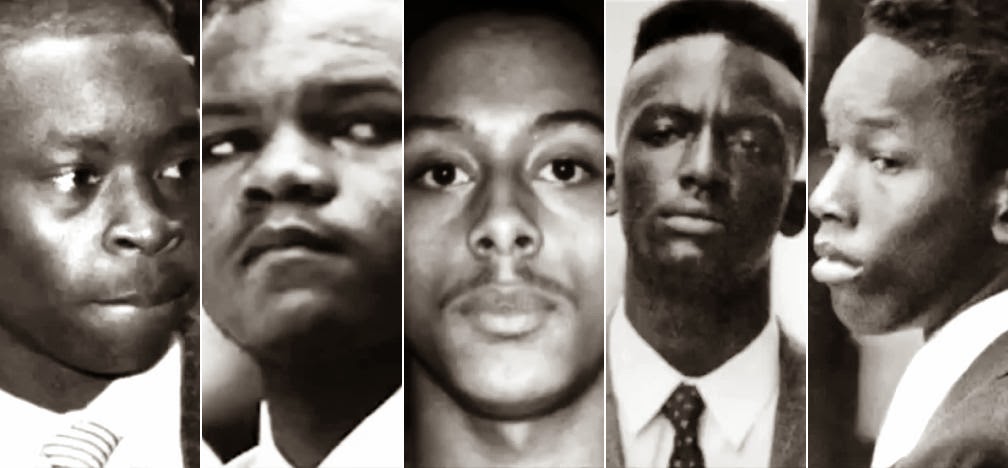TV
THE BEST PLAYER IN BASEBALL
Published
6 years agoon


It’s a Friday night and i’m finishing up some work waiting for a friend. So I click over to the Angels Seattle game and the first thing I see is the entire Angels team adorning the number 45, the number worn by their fallen teammate Tyler Skaggs who died of unknown circumstances. However there was something else that I came to realize while watching. Mike Trout really is one of the best baseball players i’ve ever seen!
The man delivers something productive practically every time I see him play. Whether i’m watching at the stadium, in an airport or at home. He’ll surely be diving in centerfield to rob a hit, stealing a base to get in scoring position or driving himself in with a 400 foot home run. His impact is beyond REAL!

If you haven’t seen him play, I suggest you catch it while you can. This level of excellence doesn’t come too often and you wouldn’t want to regret missing it. Let’s put it this way, Mike Trout signed a 12 year contract for…wait for it….$426.5 Million dollars plus a 20 million dollar bonus. And guess what? He’s not overpaid! The dude is really that good.
Mike Trout really is one of the best baseball players i’ve ever seen!
If you don’t believe me, just peep the stats. Coming into his 9th year in the league, the former rookie of the year, 2 time MVP (finished second 4 times) and 8 time all-star has been averaging 38 home runs, 101 rbi’s and a batting average of .306 per season. This is a Lebron in a lifetime type of talent with a lot more in the tank to go.
It may come as a surprise to the casual sports fan since Mike isn’t in every other commercial like most superstar athletes. But to baseball aficionados out there, this isn’t really a revelation at all. They’re just praying the Angels get some more talent around him to showcase those skills to the world or just trade him to the Yankees. I’m pretty sure New York can find a way to make some room for him.
You may like
Article
10 Easter Eggs of Segregation in Lovecraft Country Episode 1
Published
5 years agoon
August 19, 2020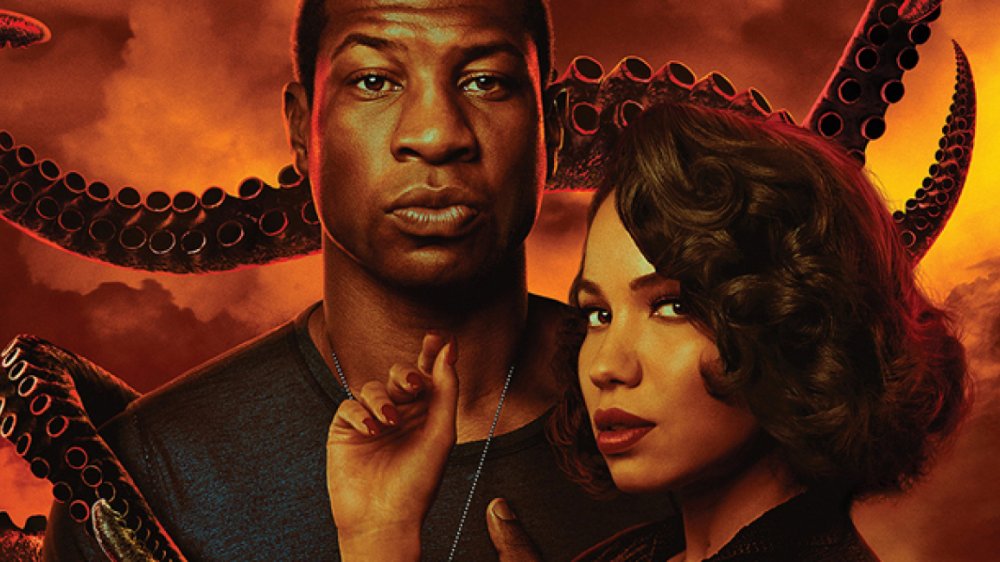
We’re all familiar with movies hiding easter eggs throughout their films sending winks and nods to pop-culture references. Sometimes it will be a tip-of-the-cap to an author, actor, or creator. Sometimes it is paying homage to an inspiring series, book, or film that’s near and dear to the director’s heart. This week I’ve seen a first. A T.V. series that has several easter eggs depicting segregation and oppression that only eagle-eyed aficionado’s of the black struggle might have caught on to.
Lovecraft Country is littered with important details that would fly over many people’s heads, and as I watched it again, I caught more nods to the true oppression of many African-Americans during the post-World War II era.
As a film buff, nothing makes me happier than watching a review, breakdown, or hidden easter egg video on a TV show I enjoy. Yesterday I did the same with Lovecraft Country, and while many of the melanin-deficient reviewers on youtube touched on the themes of literature, horror, and fantasy, many understandably missed some of the most important historical references.
Here are 10 Easter Eggs of Segregation in Lovecraft Country Episode 1.
1. H.P. Lovecraft’s little poem.
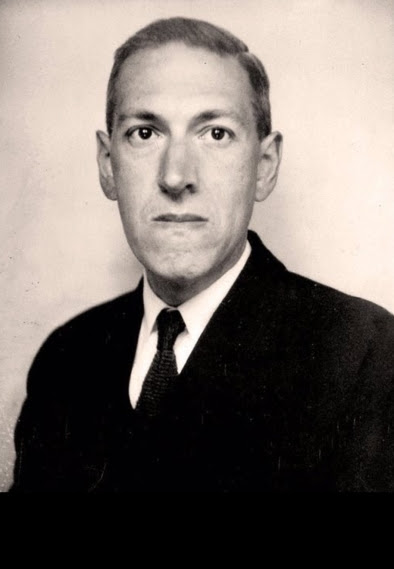
While we all know H.P. Lovecraft as an innovator of modern horror, fiction, and fantasy in literature, many people (including myself) didn’t know about a poem he wrote that spoke horribly about African Americans. Lovecraft Country alludes to the poem, but never recites it. Once they mentioned the title, I went straight to my Google Search. Below is the poem called: On the Creation of N*****s (1912)
When, long ago, the gods created Earth
In Jove’s fair image Man was shaped at birth.
The beasts for lesser parts were next designed;
Yet were they too remote from humankind.
To fill the gap, and join the rest to Man,
Th’Olympian host conceived a clever plan.
A beast they wrought, in semi-human figure,
Filled it with vice, and called the thing a N****r.
I’m sure Jackie Robinson beating the S**T out of Cthulhu at the beginning of the episode was a collective middle finger from the black community to Mr. Lovecraft.
2. Seating for Black People
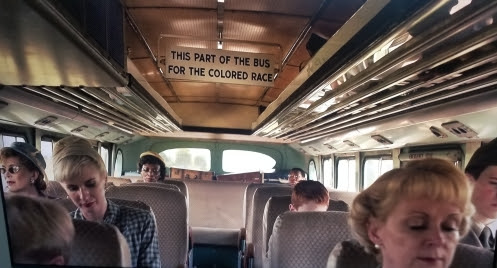
Scene from episode 1
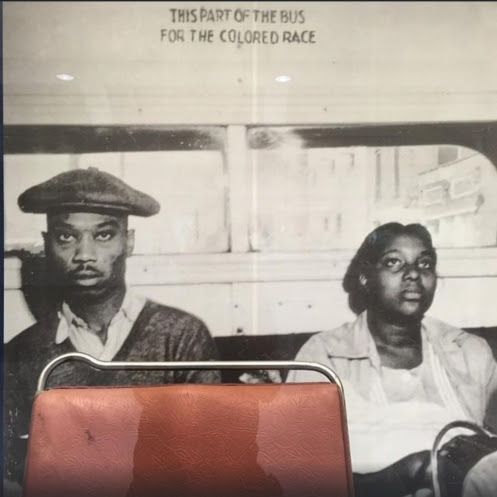
Actual photo of a segregated bus
While this may not come as a surprise to many of you, a lot of people are ignorant to the fact that, yes, black people were made to sit in the back of the bus. Many know the story of Rosa Parks’ defining moment, but for decades this was the way of life for black people. Where insult to injury is predicated in the show is when the bus breaks down and the bus driver gets a local pick-up truck driver to ride the stranded passengers into the city. Immediately in the next scene, the only two black passengers were seen walking down the road into Chicago.
3. Propaganda for the Negro Soldier
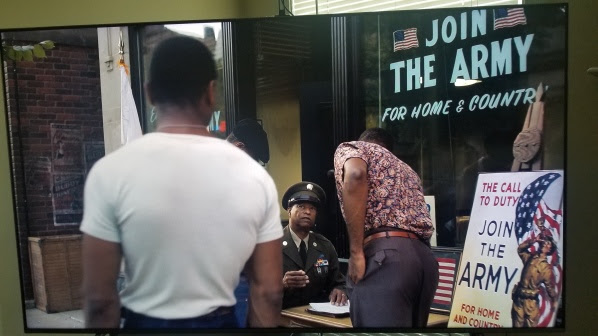

In Lovecraft Country, the above poster is not shown in this episode, but instead, it’s a black soldier telling other young black men that if they enlist, they can see the world. While Atticus walks by the soldier, there’s a glance of recognition as if Atticus was once one of those impressionable young men, and he knows their being lied to. Black men had to be enticed to enlist by different methods than whites because it was hard to show patriotism to a country that still to that day had kept them oppressed. So, they would show a poster of Joe Louis joining the fight…why don’t you? Get to see the world! Little did they know seeing the world would involve PTSD, death, and despair.
4. The Negro Motorist Greenbook
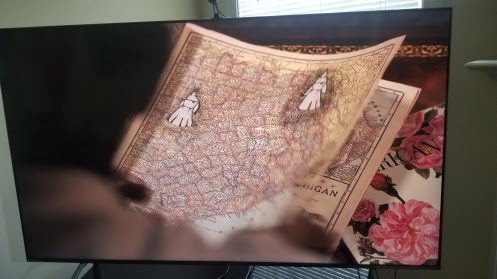
Scene from episode 1 depiction of the Green-Book
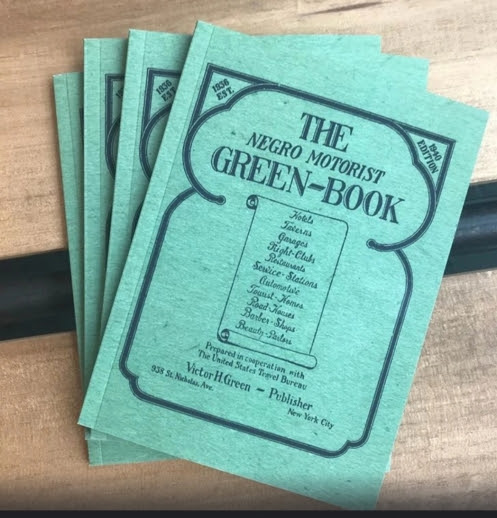
Actual Green-Book
The synopsis according to IMDB.com is: “Lovecraft Country follows Atticus Black as he joins up with his friend Letitia and his Uncle George to embark on a road trip across 1950s Jim Crow America in search of his missing father.” While this is true, it’s not the whole story. Why are they embarking on this trip? It’s to help update what many people may know as, The Negro Motorist Greenbook. Yup, just like the movie, The Greenbook. If you don’t know, this book was originated by Victor Hugo Green as a travel bible for African Americans. It provided details of safe roads to travel, places for food, repairs, and lodging where they wouldn’t be turned away or even worse, assaulted.
5. James Baldwin’s monologue on racial divide
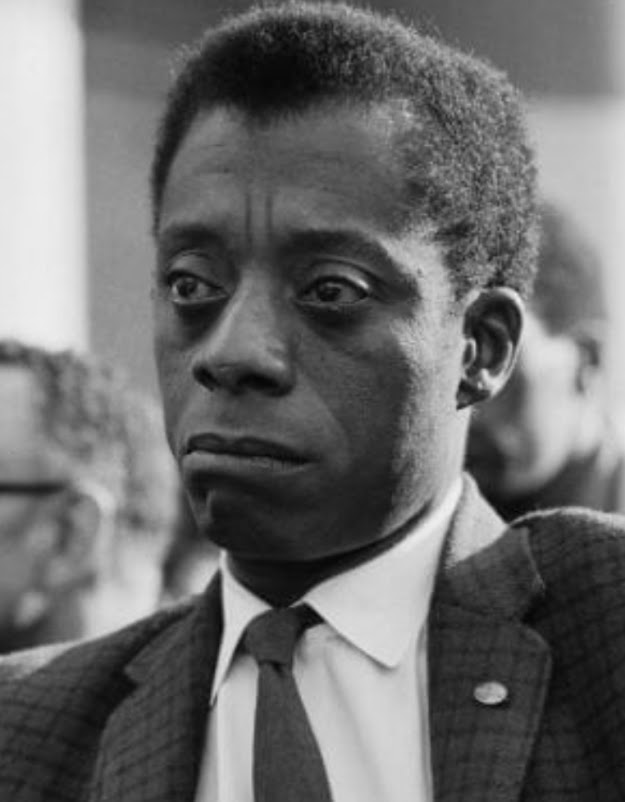
During one of the scenes in Lovecraft Country, we see a montage of our protagonist’s road trip. In the montage we see different moments where they face discrimination, others facing discrimination, and the hardships of ignorant people with all the privilege in the world monopolizing on their entitlements. Usually, during movie montages, a composer would play a score to envoke emotions during the collection of scenes. Lovecraft Country went in a different direction. Instead, they played the monologue of James Baldwin’s renowned speech at Cambridge University where he debated with William Buckley on the subject of the United States racial divide. James Baldwin was a brilliant playwright, novelist, speaker, and activist that eloquently described the plight of the black man as it still stands today. Merged with the scenes during the montage, it speaks volumes about the state of America.
6. Ice Cream stand Scene
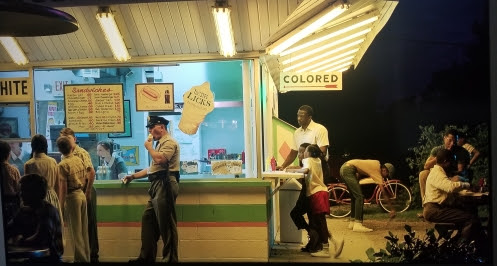
Scene from episode 1
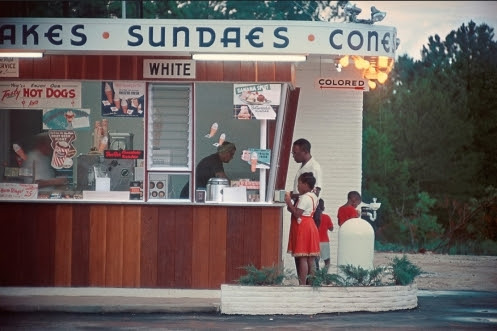
Gordon Sparks photograph
In one of the scenes in the montage, we see a black man and his children waiting at an ice cream stand for service. Right over them is a sign that says “colored” and on the other side of the stand is a group of white people with ice cream being tended to by the servers. This scene looked extremely familiar to me. When I did some research, I realized this scene was based on a famous photograph by Gordon Parks, photographer and journalist who well-documented scenes of the segregation and civil rights era. Years ago I saw his work in its full brilliant quality at the High Museum in Atlanta. The color and detail brought a realism that a black-and-white photo could never do. It made this a real thing.
7. Mother and daughter under the neon sign

Scene from episode 1
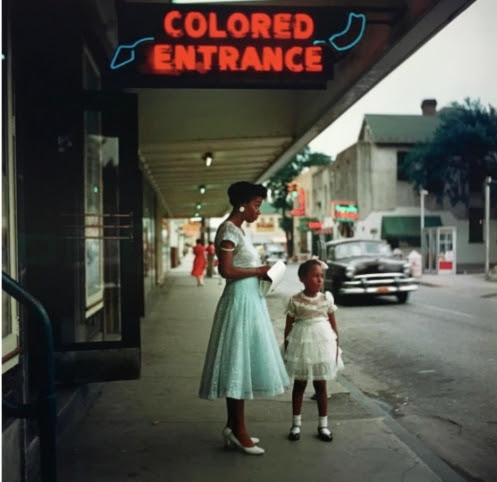
Actual photo
This scene once again pays homage to another photograph by Gordon Parks. A mother and her daughter dressed elegantly as if they were going to church, standing under a large neon sign that says ‘Colored Entrance’.
8. The billboard across from the gas station
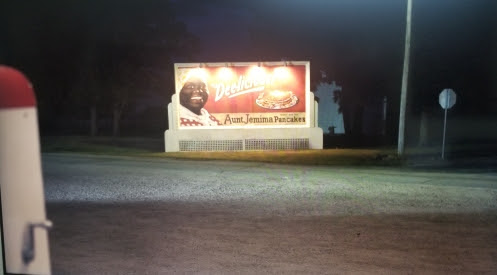
Scene from episode 1

Advertisement the billboard is based on
While Atticus and company are at a gas station filling up their car, they are approached by a gas station attendant pretending to be a gorilla to mock them. Leticia holds Atticus back from approaching the man as the attendant intensifies his ignorant behavior and she forces Atticus into the car. As they pull off, you can see a Billboard for Aunt Jemima in the background. Aunt Jemima has always been a misrepresentation of black culture through the lens of the white man and advertised to his fellow man as the overall perception of black people. The image of Aunt Jemima is a source reflection of the learned behavior of the gas station attendant.
9. Sundown towns
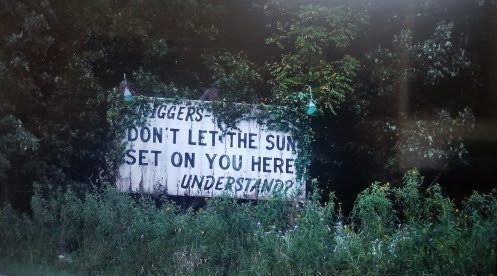
Scene from episode 1
Two years ago was the first time I’ve ever heard of a Sundown Town. No, not through a history book, but as a warning about staying too late in a little town in Texas that exists today! If I didn’t hear about this first hand, I would’ve thought it was a theme of the past, but no. There are currently county’s that do not condemn the abuse of black people once the sun goes down! While the billboard here might be a relic from the past, Sundown Towns are definitely alive and well across America!
10. White walls
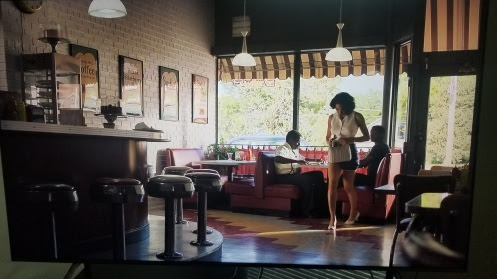
Scene from episode 1
Not only is this one telling, but it also holds all kinds of subliminal messages. While the group finds a Green book safe haven for dining called Lydia’s, they are surprised to find the restaurant is now called, Simmonsville Dinette. Still, they walk in and are greeted by unwelcoming faces. While the server goes to the back for what seems like their coffee orders, Atticus realizes that the walls are painted white. He asks his uncle to remind him why the white house was white. His uncle tells him about the war of 1812 when British soldiers torched it and when slaves were tasked to rebuild it, they had to paint it white to cover up the burn marks. This tells us two things. Lydia’s restaurant was burnt down and rebuilt by trespassers (obviously for being a safe haven for blacks in this all-white town) and the blackness of this restaurant was erased and covered up by the ‘white’ paint. My goodness, I could go on and on about this one!
I was expecting this series to be littered with easter eggs, but knowing they have incorporated easter eggs specifically about the black movement and struggles has me fired up to see what else is in store for these characters. Did you see any easter eggs that I missed? Comment and let me know.
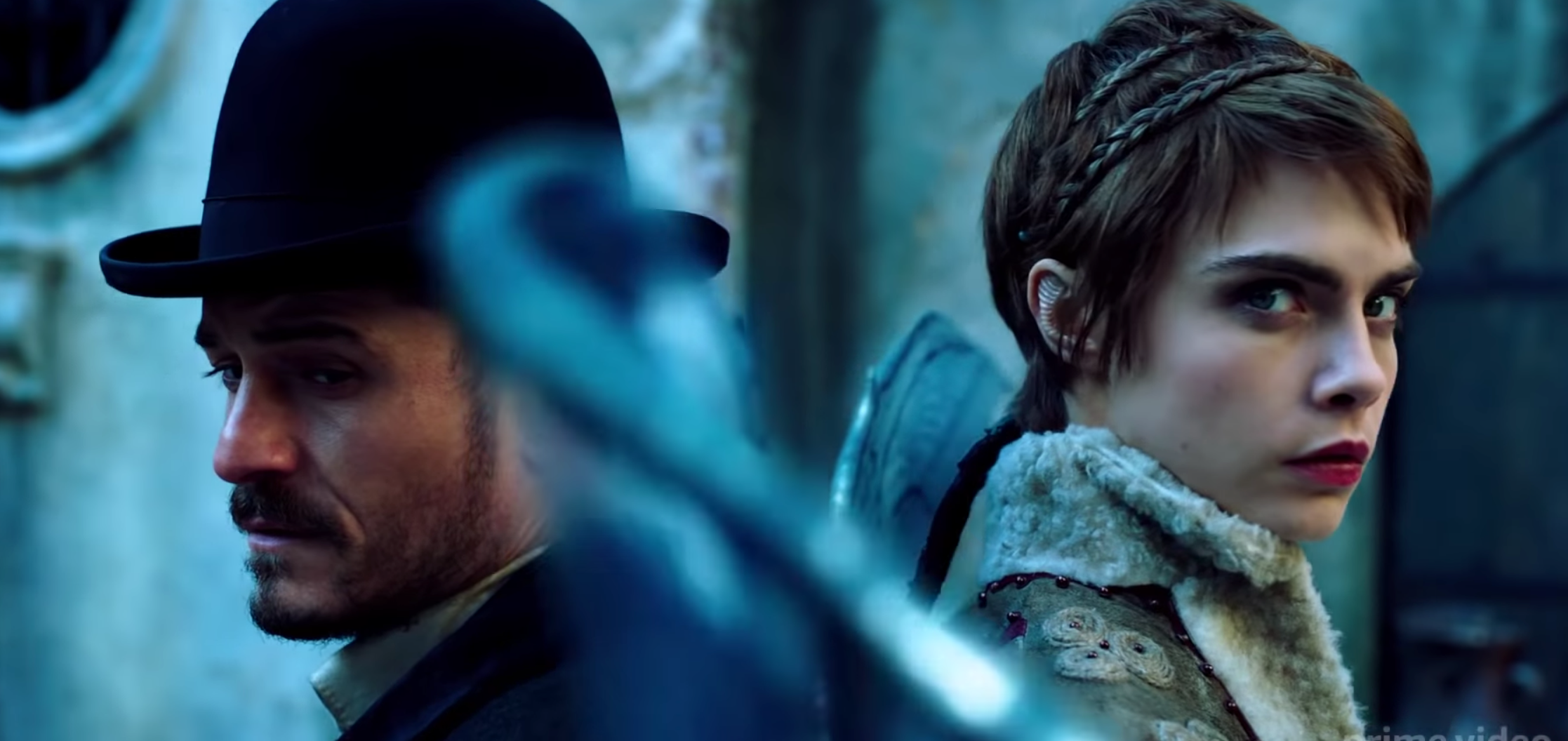
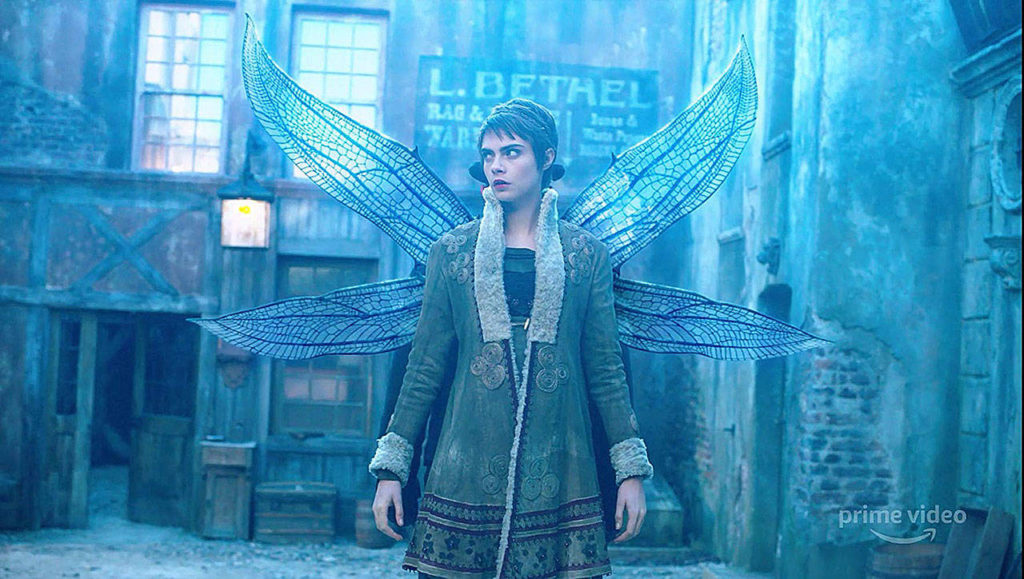
Just three episodes in and Carnival Row has me hooked and mesmerized by the sheer amount of work Amazon Studios has put into making and building a world set in a Victorian fantasy wonderland. It may feel familiar and even remind you of majestic scales seen in Harry Potter or even The Lord of the Rings but make no mistake this series stands on its own and will be the model other similar fantasy tales are told.
Amazon studios really delivered an amazingly realistic looking world!
You also get hints of Sherlock Holmes from the many British actors the show puts on display. This world not only houses humans but it also features Fauns aka Critch or Puck. Which are humans with horns attached to their heads and goat legs for…. well legs of course. The second tier of creatures are the Fae who resemble humans at first glance but instead have wings on their backs. They are a non-violent group who fled their homeland from outside invaders. They’re also called Pix. The last group of other worldly beings are called the Pact, who are no friends to the Fae. I hesitate to enter spoiler territory as the reveal of what these creatures are can be seen early in the series.
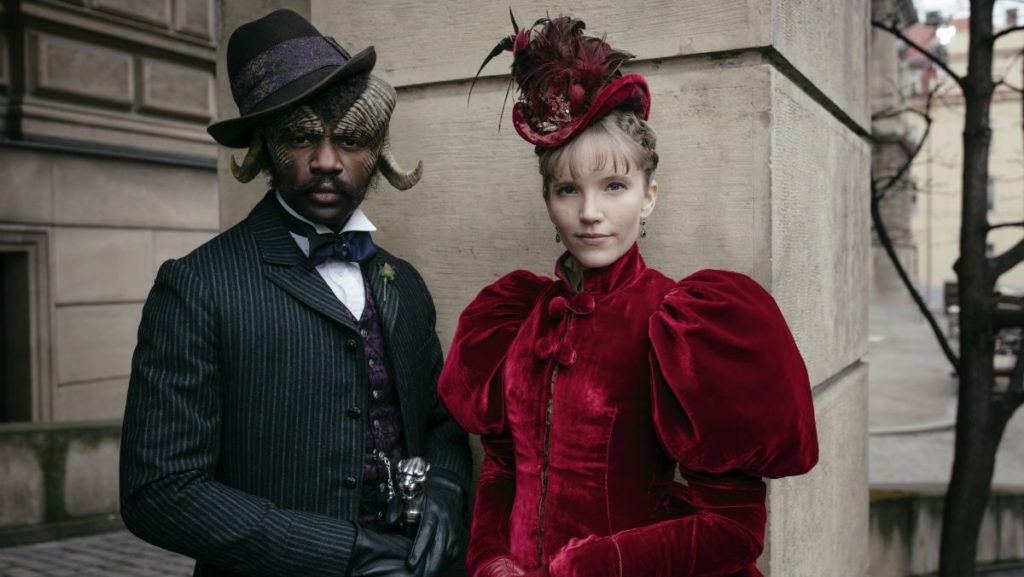
The story is essentially a civil war among three groups of people and conflicts with the overpowering government in place. Mix that with the ongoing tensions of humans and creatures attempting to live in “harmony” in one land and you have yourself an amazing story relevant to our current state of disarray in this country.
Leading the cast are actors Orlando Bloom and Cara Delevingne who wonderfully steer this complex interweaving beautiful fantasy world in the right direction, each playing characters opposite of each other but also having their own past backstory of fighting together in a war as well as a blossoming romance between them. Enough so to make their current situation even that more appealing and engaging.
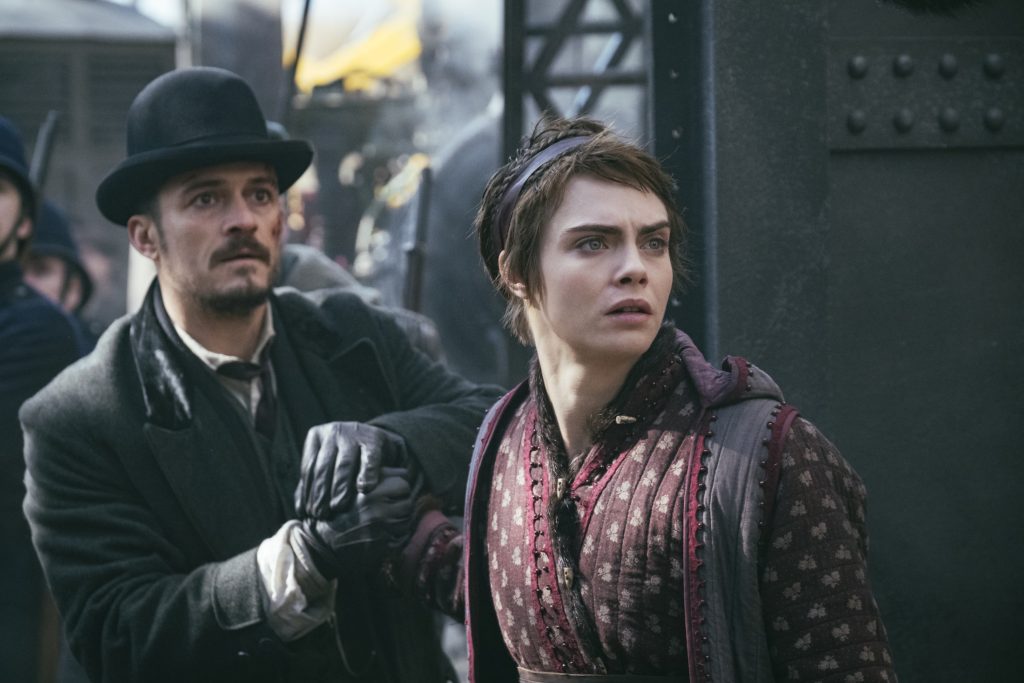
If that’s not enough there is a serial killer prowling about the city disfiguring their prey in a grotesque inhumane fashion. Another character worth mentioning is the actual city where most of the story takes place which is called the Burge. The city is brimming with life and cracks of danger lurking in each corner. Just the lighting alone from street lamps illuminating light in the dark noir city alley ways instantly puts you in that time period, not to mention the costume details of key characters. Amazon studios really delivered an amazingly realistic looking world. All worth investing your time and attention in to.
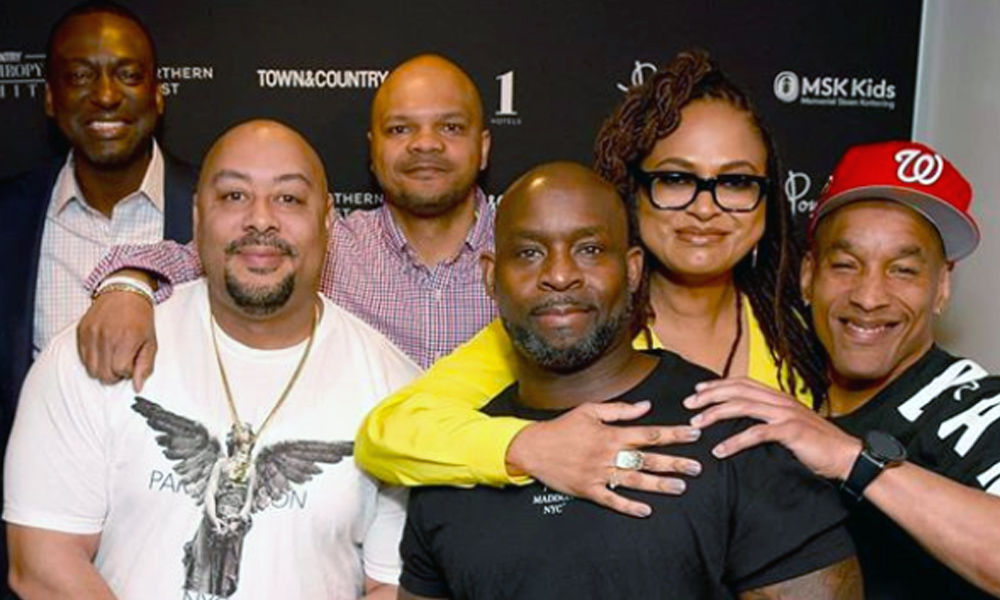
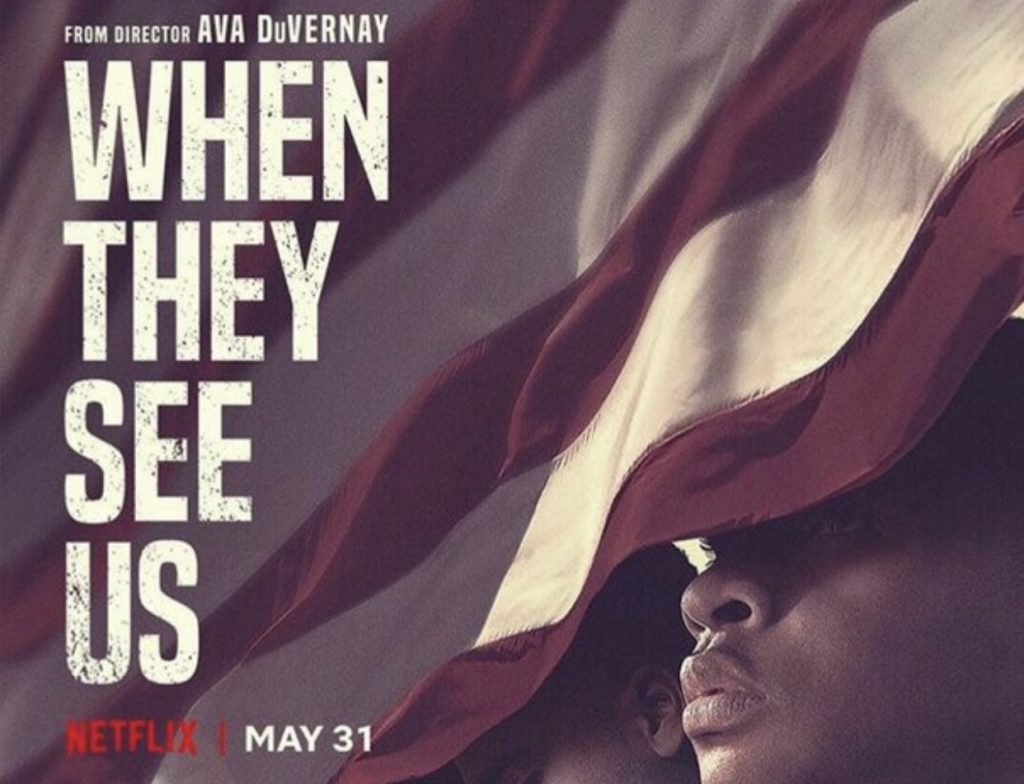
When They See Us could have easily been called When They Hate Us. The reenactment of the level of vitriol and disdain towards the lives of these children of color served as a harsh reminder of the reality we still reside in. This series is grueling, alarming and absolutely necessary for every truth seeker to watch. The ability to share our stories and provide our perspectives is a powerful tool that hasn’t always been readily available to us. But times have changed and Ava DuVernay masterfully utilizes her platform to highlight the humanity behind these victims turned heroes.
The performance of the entire cast will garner a considerable amount of attention during award season. From the dynamics of Antron McCray’s (Caleel Harris/Jovan Adepo) relationship with his father (Michael Kenneth Willams) to the strength of faith illustrated by Yusuf Salaam (Ethan Herisse/Chris Chalk) and his mother (Aunjanue Ellis), the brilliance of acting is in heavy abundance. In particular Jharrel Jerome’s heart wrenching transformation into Korey Wise has audiences around the globe streaming much more than video.
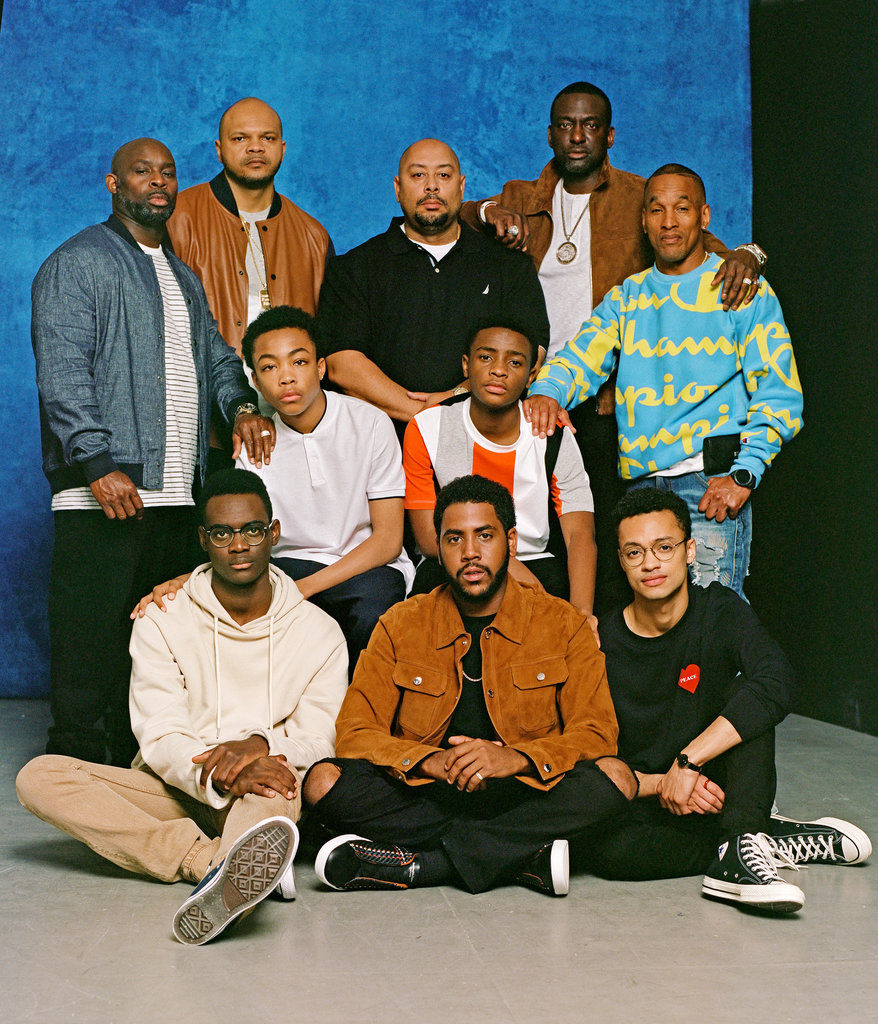
Growing up as a 14 year old child in New York City during 1989, it was nearly impossible not to be affected by the pageantry of this case. Meeting up with groups of friends, parental concerns and police interactions were brought to the forefront in daily life. This could have happened to anyone including myself. The thought of being presumed innocent before proven guilty was never a concept my peers and I ever thought applied to us. The only goal was survival and to accomplish it as best as you can.
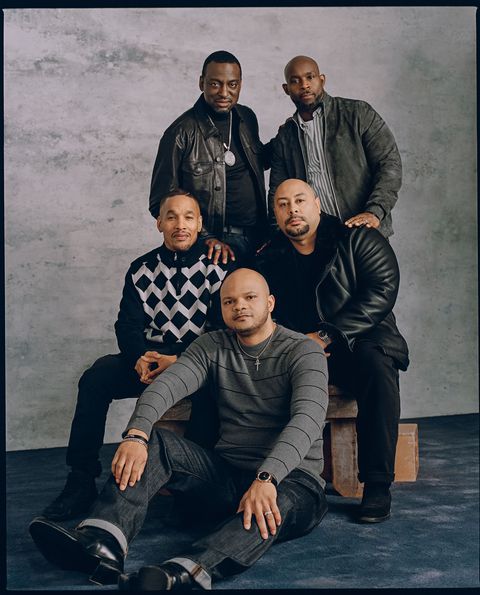
Unfortunately these kids were caught in the malicious plan of destroying black lives before they had the chance to begin. The true animals at large dealt them a fixed hand and discarded them with the expectation of never to be heard from again.
However they stayed true to themselves with the ideology of survival and persevered to expose the evil that men do. Thank you exonerated 5!
